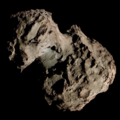 Stearns' Comet photographed by George van Biesbroeck on 13 March 1927. [1] | |
| Discovery [2] [3] | |
|---|---|
| Discovered by | Carl Leo Stearns |
| Discovery site | Van Vleck Observatory |
| Discovery date | 10 March 1927 |
| Designations | |
| 1927 IV, 1927d [4] | |
| Orbital characteristics [5] | |
| Epoch | 28 April 1927 (JD 2424998.5) |
| Observation arc | 4.005 years [6] |
| Number of observations | 17 |
| Perihelion | 3.685 AU |
| Eccentricity | 1.00127 |
| Inclination | 87.690° |
| 215.66° | |
| Argument of periapsis | 11.068° |
| Mean anomaly | 0.0002° |
| Last perihelion | 22 March 1927 |
| TJupiter | 0.100 |
| Earth MOID | 2.693 AU |
| Jupiter MOID | 1.728 AU |
| Comet total magnitude (M1) | 1.9 [6] |
| Comet nuclear magnitude (M2) | 7.5 |
Stearns' Comet, also known by its formal designation C/1927 E1, is a distant non-periodic comet that was observed from 1927 to 1931. It is the only comet discovered by Dr. Carl Leo Stearns.

